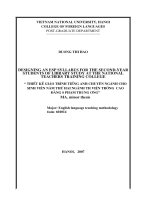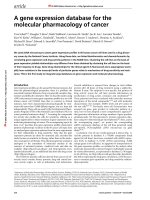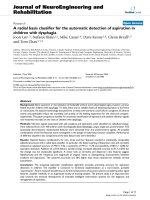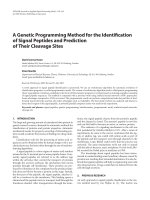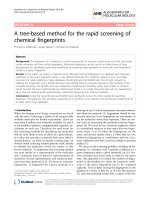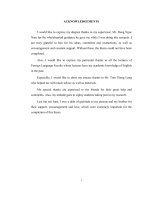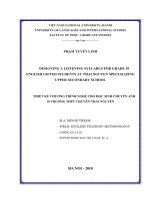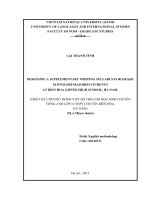Designing a task-based ESP syllabus for the second-year students of accounting at Tuyen Quang economic and technical secondary school Thiết kế chương trình tiến
Bạn đang xem bản rút gọn của tài liệu. Xem và tải ngay bản đầy đủ của tài liệu tại đây (1.02 MB, 71 trang )
1
VIETNAM NATIONAL UNIVERSITY, HANOI
UNIVERSITY OF LANGUAGES AND INTERNATIONAL STUDIES
FACULTY OF POST-GRADUATE STUDIES
*****************
NGUYỄN THỊ LÝ
DESIGNING A TASK-BASED ESP SYLLABUS FOR THE
SECOND- YEAR STUDENTS OF ACCOUNTING AT TUYEN QUANG
ECONOMIC AND TECHNICAL SECONDARY SCHOOL
THIẾT KẾ CHƯƠNG TRÌNH TIẾNG ANH CHUYÊN NGÀNH
THEO NHIỆM VỤ CHO HỌC SINH NĂM THỨ HAI
CHUYÊN NGÀNH KẾ TOÁN TRƯỜNG TRUNG HỌC
KINH TẾ KỸ THUẬT TUYÊN QUANG
M.A. MINOR THESIS
Field: English Teaching methodology
Code: 60 14 10
HANOI – 2011
2
VIETNAM NATIONAL UNIVERSITY, HANOI
UNIVERSITY OF LANGUAGES AND INTERNATIONAL STUDIES
FACULTY OF POST-GRADUATE STUDIES
*****************
NGUYỄN THỊ LÝ
DESIGNING A TASK-BASED ESP SYLLABUS FOR THE
SECOND- YEAR STUDENTS OF ACCOUNTING AT TUYEN QUANG
ECONOMIC AND TECHNICAL SECONDARY SCHOOL
THIẾT KẾ CHƯƠNG TRÌNH TIẾNG ANH CHUYÊN NGÀNH
THEO NHIỆM VỤ CHO HỌC SINH NĂM THỨ HAI
CHUYÊN NGÀNH KẾ TOÁN TRƯỜNG TRUNG HỌC
KINH TẾ KỸ THUẬT TUYÊN QUANG
M.A. MINOR THESIS
Field: English Teaching Mehodology
Code: 60 14 10
SUPERVISOR: LÊ VĂN CANH, Ph.D
HANOI – 2011
6
LIST OF ABBREVIATIONS
ESP: English for Specific Purposes
GE: General English
TQETSS: Tuyen Quang Economic and Technical Secondary School
ESS: English for the Social Sciences
EST: English for the Science and Technology
EAP: English for Academic Purposes
EOP: English for Occupational Purposes
TBLT: Task- Based Language Teaching
7
LIST OF FIGURES AND TABLES
Page
Figure 1: Bases for language syllabus design
8
Table 1: Students‟ reasons for learning English
21
Table 2: Students‟ opinions on prospective job and workplace
22
Table 3: Students‟ anticipated possibilities to use English at work in the future
23
Table 4. Ex-students‟ situations of using English at work
25
Table 5: Students‟ opinions on tasks which should be included in the course book
26
Table 6. Ex-students‟ opinions on tasks which should be included in the course book
28
Table 7: Students‟ evaluation of the current ESP course book
29
Table 8: The proposed syllabus for the second-year students of Accounting at TQETSS
(see Appendix 1)
8
TABLE OF CONTENTS
Declaration
i
Acknowledgement
ii
Abstract
iii
List of abbreviations
iv
Lists of figures and tables
v
Table of contents
vi
PART A: INTRODUCTION
1
1. Rationale
1
2. Aims and objectives of the study
1
3. Research questions
1
4. Scope of the study
2
5. Method of the study
2
6. Structure of the study
2
7. Summary
3
PART B: DEVELOPMENT
4
CHAPTER 1: LITERATURE REVIEW
4
1.1. Definition of ESP
4
1.2. Types of ESP
5
1.3. Syllabus Design
5
1.3.1 Definitions of syllabus
5
1.3.2. Approaches to ESP Language Syllabus Design
7
1.3.2.1. Language- centred approach
7
1.3.2.2. Skills- centred approach
7
1.3.2.3 Learning- centred approach
7
1.3.3. Types of syllabus
8
1.3.3.1. Structural /grammatical syllabus
9
1.3.3.2. Situational syllabus
9
1.3.3.3. Functional Notional syllabus
9
1.3.3.4. Topic-based syllabus
10
1.3.3.5. Skills-based syllabus
10
9
1.3.3.6. Process syllabus
10
1.3.4. Task-based Syllabus
11
1.3.4.1. Definition of „task”
11
1.3.4.2. Task-based syllabus
12
1.3.4.3. Characteristics of Task-based Syllabus
12
1.3.4.3. Theoretical Advantages of Task-based Syllabus
13
1.2.4.4. Limitations of Task-based Syllabus
14
1.3.5. Rationale of choosing Task-based Syllabus
15
1.3.6. Needs analysis in syllabus design
16
1.3.6.1.The important of needs analysis
16
1.3.6.2.Target needs and learning needs
16
1.4. Summary
17
CHAPTER 2: NEEDS ANALYSIS OF STUDENTS OF ACCOUNTING AT
TUYEN QUANG ECONOMIC AND TECHNICAL SECONDARY SCHOOL
18
2.1. The teaching and learning ESP at TQETSS
18
2.2. The students
18
2.3. The teachers
19
2.4. The study
19
2.4.1. The subjects
19
2.4.2. Instruments for collecting data
19
2.4.3. Data analysis and major findings
20
2.4.3.1. Data from survey questionnaires
20
2.4.3.2. Results from the interviews with ESP teachers
30
2.2.4.3. Major findings
32
2.5 Summary
33
CHAPTER 3: THE PROPOSED SYLLABUS CONTENT FOR THE SECOND-
YEAR STUDENTS OF ACCOUNTING AT TQETSS
34
3.1. Aims and objectives of the syllabus
34
3.2. Type of syllabus
34
3.3. Tasks in the syllabus
34
3.4. The proposed syllabus
35
10
3.4.1. Time schedule
35
3.4.2. The organization of the syllabus
35
3.5. Teaching and assessment methodology
35
3.5.1. Teaching methodology
35
3.5.2. Assessment methodology
36
3.6. Syllabus evaluation
36
3.7. Summary
37
PART C: CONCLUSION
38
1. Conclusion
38
2. Limitations and suggestions for further study
39
References
40
Appendices
I
Appendix 1: The proposed syllabus for the second-year students of accounting at
TQETSS
I
Appendix 2: A sample unit
V
Appendix 3: Questionnaire for students
XI
Appendix 4: Questionnaire for ex-students
XIV
Appendix 5 : Questions for interviews with ESP teachers
XVI
Appendix 6 : Transcript for interviews with ESP teachers
XVII
11
PART A: INTRODUCTION
1. Rationale
Nowadays, with the development of Science and Technology and integration and
globalization of the world economy, the demand for English in general and English for
Specific Purposes (ESP) in particular is increasing. ESP has become an insensible branch
in English language teaching in Vietnam to meet the growing demand for professional
communication and the job market in the period of international economic integration.
At Tuyen Quang Economic and Technical Secondary School, English is a
compulsory subject which are being taught to all students of all majors. It consists of two
parts: General English (GE) and English for Specific Purposes (ESP). According to the
training curriculum, the ESP course is to be delivered after students finish GE course.
However, teaching ESP has encountered a number of problems such as inappropriate
materials, content burden, lack of experience ESP teachers. The most concern of ESP
teachers is the course books. The current ESP course book for students of accounting is
compiled by the teachers of English section. After few years of implementing, it has
revealed a number of limitations in terms of content and methodology. This is because the
materials are based on the syllabus which was developed without reference to learner
needs. This gives rise to the need of developing a syllabus which is task-based and learner-
centred. And this is the motivation of this study.
2. Aims and objectives of the study
The study aims at designing a task-based ESP syllabus for the second-year students
of accounting at Tuyen Quang Economic and Technical Secondary School. To achieve this
aim, the major objectives of the study are:
- to identify the rationale for a task-based syllabus design.
- to identify the learning needs of the second-year students of accounting through a
needs analysis.
- to develop a task-based ESP syllabus which based on the learners‟ needs at Tuyen
Quang Economic and Technical Secondary School.
3. Research questions
With the aim stated above, the author proposed the three following questions for the
study:
12
1. What are the undergraduate students‟ perceived needs of ESP?
2. To what extent are the students‟ perceived needs different from those of the teachers
and ex-students?
3. How are the needs of all stakeholders transferred into tasks which are integrated in
an ESP syllabus?
4. Scope of the study
In this thesis, the author only focuses on designing a task-based ESP syllabus for
the second- year students majoring in Business accounting at TQETSS.
5. Method of the study
In order to achieve the aim mentioned above, two survey questionnaires for
undergraduate students and ex-students who were working as accountants in different
companies were used as one of the tools to collect information about the students' needs as
well as to identify tasks which should be included in the syllabus for the second-year
students of accounting. Also, informal interviews with ESP teachers were conducted in
order to know about their opinions of tasks to be included in the syllabus and their
experience in doing needs analysis. Thus, both quantitative and qualitative methods were
employed in this study.
6. Structure of the study
The study is divided into three parts:
Part A is the introduction including the rationale, the aims, the research questions,
the scope, the method and the structure of the study.
Part B is the development that consists of 3 chapters:
- Chapter 1 is about literature review of ESP and syllabus design
- Chapter 2 presents situational analysis of ESP teaching and learning at TQETSS
and gives descriptions of subjects of the study, instruments for data collection and
analysis of the results from two questionnaires and interviews.
- Chapter 3 proposes an ESP task-based syllabus for the second- year students of
accounting at TQETSS with the methodology of teaching and assessment and
syllabus evaluation.
Part C is the conclusion that consists of concluding ideas, limitations and
suggestions for further study.
13
7. Summary
This part presents the rationale of designing a task-based syllabus for the second-year
students of accounting at Tuyen Quang Economic and Technical secondary school. Also,
the aims, the research questions, the scope, the methodology and the structure of the study
are presented. The Literature review, Needs analysis and the Proposed syllabus will be
presented in the part B below.
14
PART B: DEVELOPMENT
CHAPTER 1: LITERATURE REVIEW
1.1. Definitions of ESP
There are many definitions of ESP. Hutchinson and Waters (1987) see ESP as an
approach rather than a product, by which they mean that ESP is not a particular kind of
language or methodology. They point out that ESP is an approach to language learning,
which based on learner need “ESP is an approach to language teaching which aims to meet
the needs of particular learners” Hutchinson and Waters (1987:21). The foundation of all
ESP is the simple question: Why does this learner need to learn a foreign language? They
include: “ESP is an approach to language teaching in which all decisions as to content and
method are based on the learner‟s reason for learning”.
Taking the same point of view, Robinson (1991) also accepts the primary of need
analysis in defining ESP. She considers “ESP is normally goal directed”, and that ESP
course is based on a need analysis, which „aims to specify as closely as possible what
exactly is it that students have to do through the medium of English‟ (Robinson, 1991:3).
In more detailed approach to characteristics, Streven (1988) defines ESP by
identifying and making a distinction between its absolute and variable characteristics:
Absolute characteristics: are that ESP consists of English language teaching, which
is (1) designed to meet specified needs of the learner; (2) related in content (i.e. in its
themes and topics) to particular disciplines, occupation and activities; (3) centred on the
language appropriate to those activities in syntax, lexis, discourse, semantics, etc., and
analysis of this discourse; (4) in contrast with General English.
Variable characteristics: are that ESP may be, but is not necessarily: (1) restricted as
to the language skills to be learned (e.g. reading only); (2) not taught according to any pre-
ordained methodology.
Dudley- Evans and St John (1998: 4-5) assert that ESP is likely to be used with adult
learners, either at tertiary level institution or in a professional work situation, although it
could be used with young adults in the setting of a secondary school. Additionally, they
note that ESP is generally designed for intermediate or advanced students and most ESP
course assume some basic knowledge of the language system, but it can be used with
beginners.
15
1.2. Types of ESP
According to Hutchinson and Waters (1987:16) ESP is divided into three branches,
namely English for the Science and Technology (EST), English for Business and
Economics (EBE) and English for the Social Sciences (ESS). Each of these subject areas is
further divided into two branches: English for Academic Purposes (EAP) and English for
Occupational Purposes (EOP). Nevertheless, Hutchinson and Waters do emphasize that
there do not exist a clear distinction between EAP and EOP because: “people can work and
study simultaneously, it is likely that in many cases the language learnt for immediate use
in a study environment will be used later when the students take up, or return to , a job”.
Carter (1983) identifies three types of ESP as: English as a restricted language,
English for Academic and Occupational Purposes, English with specific topics. He states
the first type of ESP is English as a restricted language. The language used by engineers or
by businessmen is examples of English as a restricted language. The second type of ESP is
English for Academic and Occupational Purposes. Taking the same point of view with
Hutchinson and Waters (1987), there is not a clear distinction between EAP and EOP. He
groups EAP and EOP together in the same type of ESP. The final type is English with
Specific topics which is concerned with anticipated future English needs.
In sum, studying various types of ESP will provide ESP teachers with an overall
picture of the group of learners they are going to work with. This is the initial step which
enables the ESP teachers to succeed in conducting a needs analysis in order to design an
appropriate ESP course for their target students.
1.3. Syllabus Design
1.3.1 Definitions of syllabus
The notion of „syllabus‟ has been defined in some different ways by many authors.
There are several conflicting views on the distinction between syllabus design and
curriculum development. Some authors advocate the narrow view which draw a clear
distinction between syllabus design (concerned essentially with the selection and grading
content) and methodology (concerned with the selection of learning tasks and activities)
whereas some others adopt a broader view which argue that with advent of communicative
language teaching, the distinction between content and tasks is difficult to sustain.
16
Some authors who advocate the broader view such as Breen (1984), Yalden 1984)
suppose that the selection of content to teach and methodology are combined in the
syllabus. Yalden (1984: 14) points out:
“[The syllabus] replaces the concepts of „method‟, and the syllabus is now seen as an
instrument by which the teacher, with the help of the syllabus designer, can achieve
a degree of „fit‟ between the need and aims of the learner (as social being and as
individual) and the activities which will take place in the classroom”. (cited in
Nunan, 1988:4).
In a similar vein, Breen (1984:49) states: “Any syllabus will express- however
indirectly- certain assumption about language, about the psychological process of learning,
and about the pedagogic and social processes within a classroom”. (cited in Nunan,
1988:4).
In contrast to a such broad view, authors advocating a more narrow view (for
instance Nunan, 1988; Hutchinson and Waters, 1987; Allen, 1984) argue that syllabus
design and methodology should be distinctive and separate.
According to Allen (1984:61) “a syllabus is concerned with a specification of what
units will be taught (as distinct from how they will be taught, which is a matter for
methodology)”. (cited in Nunan, 1988:6).
Hutchinson and Waters (1987:80) also hold the same view with Allen: “A syllabus is
a document which says what will (or at least what should) be learnt”.
Likewise, Nunan (1985) views syllabus design as being concerned essentially with
the selection and grading content, while methodology is concerned with the selection of
learning tasks and activities.
In summary, the term „syllabus‟ could be defined narrowly or broadly. With the aims
of designing a task- based ESP syllabus for students of accounting and the current context
of teaching and learning ESP at TQETSS, the author will adopt the broad view. This is
because the issue is that no matter what the designers will select to form a syllabus, it must
combine the appropriate language content for the target- learners and the methodology
which can help the learners perceive the most of what the syllabus means to be. Equally
important, the needs of learners must be taken in focus due to the fact that syllabus is
designed in respond to what the learners wish to obtain.
17
1.3.2. Approaches to ESP Syllabus Design
So far, there have been many different approaches to language syllabus design.
Wilkins (1976) makes a distinction between analytic and synthetic approaches.
Nevertheless, Hutchinson and Waters (1987) identify three main approaches to ESP
syllabus design as: the language- centred, skills- centred and learning- centred. These are
discussed below.
1.3.2.1. Language- centred approach
This process is the simplest and probably the most familiar to English teachers. It is
particularly prevalent in ESP. Hutchinson and Waters (1987: 65) point out that this design
process “aims to draw as direct a connection as possible between the analysis of the target
situation and the content of the ESP course”. This approach may seem to be a very logical
procedure. It starts with the learner, proceeds through various stages of analysis to a
syllabus, thence to materials in use in the classroom and finally to evaluation of mastery of
the syllabus items.
Although this approach seem to be logical and straightforward, it also has a number
of weakness: First, it starts from the learners and their needs, but it is, in fact, not learner-
centred in any meaningful sense of the term because the learners is simply used as a means
of identifying the target situation. Second, it can also be criticised for being a static and
inflexible procedure. Third, it appears to be a systematic and systematic analysis and
presentation of language data will produce systematic learning in the learner. Finally, its
analysis of target situation data is only at the surface level and reveals very little about the
competence that underlines the performance.
1.3.2.2. Skills- centred approach
According to Hutchinson and Waters (1987: 69) “a skills- centred approach aims to
get away from the surface performance data and look at the competence that underlines the
performance”. Thus, a skills-centred course will present its learning objectives in terms of
both performance and competence. It can be seen as helping learners to develop skills and
strategies which will continue to develop after the ESP course itself with the aim of not
providing a specified group of linguistic knowledge but making the learners into better
processors of information. However, it still approaches the learner as a user of language
rather than as a learner of language and it is concerned with the process of language use
not of language learning.
18
1.3.2.3. Learning- centred approach
Hutchinson and Waters (1987:72) state “learning is seen as process in which the
learners use what knowledge or skills they have in order to make sense of the flow of new
information”. In this approach, learners are not the only concern of the learning process,
and learning process is not totally decided and based on the learners but should be seen in
the context where it take place. This approach takes account of the learners at every stage
of the design process and it does not only consider the learners‟ competence but also how
the learners acquire that competence.
To sum up, the learning-centred approach pays attention to competence and
performance of the learners, while the skills-centred approach views learner as a user
rather than a learner of language. The language-centred approach makes the ESP course
too dependent on the target situation. Each approach has its own advantages as well as the
drawbacks. Having perceived the advantages of the learning-centred approach, I take this
approach as the basis for designing an ESP syllabus for the students of Accounting at
TQETSS.
1.3.3. Types of syllabus
There are different types of syllabuses. White (1988:46) points out three main types
including Content-based syllabus, Skills-based syllabus and Method-based syllabus. These
three types of syllabuses can be subdivided into sub-types of syllabus which consists of
structural/grammatical syllabus, situational syllabus, function notional syllabus, topic-
based syllabus, skills-based syllabus, task-based syllabus and process syllabus.
CONTENT SKILL METHOD
FORM TOPIC LANGUAGE LEARNING PROCESS PROCEDURAL
Structural Informational Receptive/ Skill acquisition Learning Cognitive focus
focus focus Productive focus focus Task-based
Learner- led
SITUATION FUNCTIONAL
Contextual focus Notional/ Functional focus
Figure 1. Bases for language syllabus design (White, 1988:46)
Bases for
language syllabuses
19
1.3.3.1. Structural/ Grammatical syllabus
This type of syllabus assumes that the learner‟s need is for items which can cope
with what is, after all, a grammar demand. So the focus of the structural syllabus is the
grammatical structure of the language. Most language teaching materials deriving from
structural syllabuses reflect the point of view that language is a grammatical system and
learning a language consist of learning that system.
A fundamental criticism on the grammatical syllabus is that it focuses on only one
aspect of language, namely grammar, whereas in reality there exist many more aspects to
language. “Structural-graded syllabuses misrepresented the nature of that complex
phenomenon language. They did so in tending to focus on only one aspect of language,
that is formal grammar” (Nunan, 1988:30).
1.3.3.2. Situational syllabus
According to Richards (2001:156) “situational syllabus is one that is organized
around the language needed for different situations such as at the airport or at a hotel”.
This syllabus identifies the situations in which the learners will use the language and the
typical communicative acts and language used in that setting. Situational syllabuses “have
the advantage of presenting language in context and teaching language of immediate
practical use” (Richards, 2001:156). However, a situational syllabus will be limited for
students whose needs were not included by the situations in the syllabus.
1.3.3.3. Function Notional syllabus
Functional syllabus is “one that is organized around communicative functions such
as requesting, complaining, suggesting, agreeing” (Richards, 2001:155). The most salient
feature that characterizes this type of syllabus is that it “takes the desired communicative
capacity as the starting point” (Wilkins, 1976:18).
The advantage of the notional syllabus is that “functional-notionalism has the
„tremendous merit‟ of place the students and their communicative purposes at the centre of
the curriculum” (Finocchiaro and Brumfit, cited in Nunan, 1988:36). However, a
functional- notional syllabus presents some drawbacks. Firstly, it provides simple series of
isolated functions that do little with the development of communicative competence.
Secondly, the content is restricted to specific of use to perform many functions. Thirdly,
functional content is confined to short utterances and units of discourse. Larger structures
20
of discourse may be ignored and students may fail to handle the new language in longer
discourse.
1.3.3.4.Topic- based syllabus
This type of syllabus is organized around themes, topics or other units of contents.
With a topical syllabus, content rather than grammar, functions or situations is the starting
point in syllabus design.
This syllabus has the following advantages. “it motivates the student and a basis for
the „real‟ syllabus of the language forms, functions or whatever the course designers wish
to focus on” (Robinson, 1991:37). The content in topic-based syllabus makes linguistic
form more meaningful and serves as the best basis for teaching the skill areas. However,
there are issues that arise in developing a topic- based syllabus. It is much more difficult to
monitor the balance between content and grammar or other strands in the syllabus. And it
is difficult to decide the basis for assessment - learning of content or learning of language.
1.3.3.5. Skills -based syllabus
Skills-based syllabus is organized around the different underlying abilities that are
involved in using a language for purposes such as reading, writing, listening or speaking.
Skills-based syllabus has the advantage of focusing on behavior or performance in
relation to specific tasks and therefore provide a practical framework for designing courses
and teaching materials. It teaches skills that can transfer to many other situations.
However, this type of syllabus presents some shortcomings. Firstly, “there is no serious
basis for determining skills”. Secondly, it focuses on discrete aspects of performance rather
than developing more global and integrated communicative abilities (Richards, 2001:161).
1.3.3.6. Process syllabus
Process syllabus can be described as a quite innovative one for it is largely on project
work and problem- solving tasks and activities. In the process syllabus the course
materials, content and teaching methods are negotiated between the teachers and the
students thus ensuring its innovative nature. However, White (1988:101) states some
problems with this syllabus: The first problem is that there exists no evaluation of such a
model in practice. Secondly, the process syllabus calls for considerable professional
competence and confidence on the part of teachers. Thirdly, there is inadequate provision
within the proposals for relating the syllabus to the context in which it will occur. Fourthly,
21
the redefinition of roles which such an approach to syllabus design entails. It is not only
the teacher who has to change roles- the students do too.
In sum, each syllabus type has both strong points and limitations. Thus, the choice of
a particular syllabus type depends on the course objectives and the contextual factors such
as the teachers, the learners, the nature of the course, etc. In this study, a Task-based
syllabus was chosen for the ESP course in Accounting at TQETSS. This type of syllabus
will be discussed in details in section 1.3.4 below.
1.3.4. Task-based Syllabus
1.3.4.1. Definition of ‘task’
There has been a number of definitions of „task‟ given by different authors. A broad
definition, such as that provided by Long (1985) include tasks that require language and
tasks that can be performed without using language. He defines a task is „a piece of work
undertaken for oneself or for others, freely for some reward. Thus, examples of tasks
including painting a fence, dressing a child, filling out a form, buying a pair of shoes,
making an airline reservation….In other words, by „task‟ is meant the hundred and one
things people do in everyday life, at work, at play and in between. “Tasks” are the things
people will tell you they do if you ask them and they are not applied linguists.‟ (cited in
Ellis, 2003:4).
According to more narrow definitions, such as those by Richards, Platt, and Weber
(1985), and Nunan (1989), task is defined as an activity that necessarily involves language.
For example, Richards, Platt, and Weber (1985, cited in Ellis, 2003:4) define task as „an
activity or action which is carried out as the result of processing or understanding
language, i.e., respond. a task usually requires the teacher to specify what will be
regarded as successful completion of the task‟. Nunan (1989:10) defines a communicative
task is “a piece of classroom work which involves learners in comprehending,
manipulating, producing or interacting in the target language while their attention is
principally focused on meaning rather than form”.
In his recent work that looks at „task‟ more from a language acquisition perspective
than a pedagogical one (although it does also deal with aspects of pedagogy), Ellis
(2003:16) defines task in the following way: “A task is a workplan that requires learners
to process language pragmatically in order to achieve an outcome that can be
evaluated in terms of whether the correct or appropriate propositional content has
22
been conveyed. To this end, it requires them to give primary attention to meaning and to
make use of their own linguistic resources, although the design of the task may
predispose them to choose particular forms. A task is intended to result in language use
that bears a resemblance, direct or indirect, to the way language is used in the real world.
Like other language activities, a task can engage productive or receptive, and oral or
written skills and also various cognitive processes”.
In sum, all definitions of task reviewed in this chapter emphasize the fact that tasks
involve communicative language use in which the user‟s attention is focused on
meaning rather than grammatical form. This does not mean that form is not important.
Meaning and form are highly interrelated, and grammar exists to enable the language user
to express different communicative meanings and learners will acquire grammar as a by-
product of carrying out tasks.
1.3.4.2. Task-based syllabus (Procedural syllabus)
Robinson (1991:39) states “the procedural or task-based syllabuses consist of a set of
tasks or activities ordered according to cognitive difficulty class time is devoted to
performance of the tasks and attention is only consciously directed to language if this is
necessary for completion of the task. A major concern is that students understand the task
and what they are doing, and do not act in a mechanical way”.
Task-based teaching differs from situation- based teaching in that while situational
teaching has the goal of teaching language content that occurs in the situation (a predefined
product), task- based teaching has the specific has the goal of teaching students to draw on
a variety of language forms, functions, and skills, often in an individual and unpredictable
way, in completing the tasks. The aim of the task-based syllabus is to compose the
language syllabus that would stimulate real communication in the foreign language.
According to Robinson (1991:40), this type of syllabus has proved to be of great
significance for ESP because “using the medium of English, they should successfully
perform work of a study task”.
1.3.4.3. Characteristics of Task-based Syllabus
A task-based syllabus represents a particular realisation of communicative language
teaching. In other words, what arguably permeates it is the need to act as an interface
between purely pedagogical goals and real-world activities. So, instead of making lists of
grammatical, notional-functional, and other items, the designer should conduct a needs
23
analysis, which is instrumental in yielding a list of the target tasks that learners will need to
carry out in the real world outside the classroom.
A task-based syllabus is based on task-based learning, an approach where learners
carry out tasks such as solving a problem or planning an activity. The language learnt
comes out of the linguistic demands of the activity. A task-based syllabus is structured
around a series of the tasks. The characteristics of task- based syllabus are:
(i) task-based instruction is potentially very powerful and widely applicable.
(ii) suitable for learners of all ages and backgrounds.
(iii) addresses the crucial problem-directly, by using active and real tasks as learning
activities.
(iv) ability to perform the instructional task is equivalent to the ability to use the
language, so functional ability should be a natural outcome of the instructional experience.
(v) task-based learning can be very effective when the learners are engaged in
relatively similar out-of-class activities (social or academic).
(vi) task-based learning can be especially useful for learners who are not accustomed
to more traditional type of classroom learning or who need to learn cognitive, cultural, and
life skills along with the language.
1.3.4.4. Theoretical Advantages of Task-based Syllabus
Task-based syllabus has following major advantages: adequate consideration of need
analysis, authenticity of materials, humanistic orientation, and variety of tasks.
The first advantage is task-based syllabus is concerned with adequate consideration
of needs analysis. Tasks are selected based on the needs analysis of learners. As a result,
they can satisfy their demands. Moreover, Nunan (2000) states a task is a communicative
activity that does not usually have a restrictive focus on a single grammatical structure. It
also had a non-linguistic outcome. Consequently these authentic tasks can promote
students‟ motivation and interest, which are of great importance to the second language
acquisition.
Secondly, it is advocated that tasks involve authentic materials targeted real-life
contexts. The authentic input, therefore, will facilitate students‟ foreign language
acquisition. In addition, authentic material and situations shall promote learners‟ ability of
coping with real problems.
The third advantage is the task-based syllabus associates with humanistic orientation.
24
Humanistic approaches encourage students put them to use by caring for and sharing with
others. In the process of completing the task, students are encouraged to negotiate their
meaning, to cooperate with other members in the group. Thus, their communicative
competence is developed. More importantly, they learn to be a social man in the process of
completing the task, which manifests the humanistic view of language education.
Lastly, task-based syllabus is organized around variety of tasks. The application of a
repertoire of tasks is considered as a practical means of broadening learners‟ potential to
varied dynamic communicative situations or dynamic social and occupational roles.
1.3.4.5. Limitations of Task-based Syllabus
Like many other types of syllabus, apart from advantages, the task-based syllabus has
its own limitations as follow.
The first limitation is the ambiguity of definition of „task‟. Definitions of tasks are
sometimes so broad to include almost anything that involves learners doing something
(Richards, 2001:162). In spite of the many definitions provided by scholars, however, so
far no agreement has been achieved on the nature of “task”. As Long & Crookes (1993)
states "no complete program has been implemented and evaluated which has fully
adopted even the basic characteristics of TBLT much less the detailed principles for
making materials design and methodological decisions”. So we have good reasons to
challenge the product based on unclear definition and inadequacy of empirical proof.
Second, task-based syllabus tends to ignorance of other functions of language. From
a multi- functional view of language, some people hold that task-based syllabus may
restrict the way in which language is used, causing learners to miss out on experiences that
maybe of crucial importance for successful language learning. As for me, this argument
against task-based language teaching including task-based syllabus seems to lack adequate
evidence. Actually, language function is realized through language itself. I think as long as
use of language is involved, all types of functions of language are realized at the same
time. It is not necessarily for the task-based syllabus (in fact for any syllabus) to cover
everything.
The third limitation of the task-based syllabus is the difficulty of grading the
difficulty level of task. In fact, it is difficult to grade the difficulty level of task. The
difficulty level of a certain task is not solely depend on the linguistic items, but it also has
25
something to do with other factors such as the knowledge, the cognitive ability of the task
performer and the objective of the task.
The fourth limitation of the task-based syllabus is scant attention to form. Still some
scholars show their concern about potential tendency generated by task-based syllabus, that
is, student will pay less attention to the form of language. As suggested by Skehan (1996)
excessive focus on meaning during task completion will confine learners to the strategic
solutions they develop and pay little attention to structural change or accuracy. Thus, it will
be necessary "to devise methods of focusing on form without losing the values of tasks as
realistic communication motivators, and as opportunities to trigger acquisitional processes"
(Skehan 1996:42).
Lastly, problems in practice is a concern of the task-based syllabus. Task-based
syllabus makes the teaching job demanding. As we can see, task-based syllabus poses a
great challenge to the proficiency level of the teachers, which might be a problem in the
EFL situation. Also the authentic data, the design of authentic tasks might become the
obstacles to the implementation of the syllabus.
1.3.5. Rationale of choosing Task-based Syllabus
Since the students of Business accounting are supposed to work in different
enterprises, firms and companies after graduation especially in the era of integration of the
world economy, they are expected to undertake various tasks using English. Taking this
into consideration, I think a task-based syllabus could be a better choice to design an ESP
syllabus for the students of accounting at TQETSS because of the four following reasons:
First, task-based syllabus represents a particular realisation of communicative
language teaching, it promotes the eventual uses of the target language by emphasizing the
real-world resemblance of the tasks with the purpose of preparing the students for the real-
world tasks. Second, as Robinson (2001:267) states tasks derived from the analysis of
learners‟ needs increases learners‟ interest and motivation. Third, while performing tasks,
learners can learn the target language through contextualized and meaningful use of the
language rather than learning sentence-level usage of the language. Fourth, tasks presented
with gradually increasing complexity provide rich, elaborated, and comprehensible input
for the language acquisition to occur.
26
1.3.6. Needs analysis in Syllabus Design
1.3.6.1.The important of needs analysis
With the development of the field of ESP, there emerged a tendency that students‟
needs must be examined and considered in the design of the syllabuses. Needs analysis is
considered as the initial process for the specification of behavioral objectives. It is from
these objectives that detailed aspects of the syllabus such as functions, topics, lexis and
structure are derived. Nunan (1988:75) states “Needs analysis refers to a family of
procedures for gathering information about learners and about communication tasks for use
in syllabus design”.
Need analysis can have a marked influence on the shape of the syllabus on which the
course is based because when a needs survey is being taken, there is potentially a great of
information to be gathered. To establish a workable syllabus design, needs analysis is
suggested as the most careful concern.
1.3.6.2.Target needs and learning needs
Under the general heading of needs, Hutchinson and Waters (1987) identify as
targets needs and learning needs.
Target needs: target needs is “what learners need to do in the target situation”. Hutchinson
and Waters (1987:55) look at the target situation in terms of necessities, lacks and wants as
follows:
i) Necessities: They call „necessities‟ the type of need determined by the demands of the
target situation; that is what the learner has to know in order to function effectively in the
situation.
ii) Lacks: Since the concern in ESP is the needs of particular learners, to identify
necessities alone is not enough. It is important to know what the learner knows already, so
the designers can decide “which of the necessities the learners lacks”. The target
proficiency needs to be matched against the existing the proficiency of the learners. The
gap between the two can be referred to the learner‟s lack (Hutchinson and Waters,
1987:56).
iii) Want: Learners‟ want and their view about the reasons why they need language should
be concerned. Learners will may well have a clear idea of the “necessity” of the target
situation: they will certainly have a view as to their „lack‟. But it is quite possible that the
learners‟ views will conflict the perception of other interested in parties: course designers,
27
sponsors, and teachers. What is important is that the ESP course designer or teacher is
aware of such differences and takes account of them in materials and methodology. Thus, a
satisfactory syllabus should meet the needs of all related parties.
Learning needs:
Hutchinson and Waters (1987) use the analogy of the ESP course as a journey in
which „lack‟ is regarded as the starting point, „necessities‟ as the destination and “how we
are going to get from the starting point to the destination” indicates another kind of need:
learning needs. The whole ESP process is concerned not with „knowing‟ or „doing‟ but the
„learning‟. It is naive to base a course design simply on the target objectives, just as it is
naive to think that a journey can be planned solely in terms of the starting point and the
destination. The needs, potential and constraints of the route (i.e. the learning situation)
must also taken into account if we are going to have an useful analysis of learners needs.
Hutchinson and Waters (1987:61).
In sum, both target situation needs and learning needs must be taken into account.
Analysis of target situation can tell us what people do with language. what we also need to
know is how people learn to do what they do with language. We need, in other word, a
learning- centered approach to needs analysis.
1.4. Summary
This chapter has discussed an overview of ESP and syllabus design, types of
syllabus, approaches to ESP syllabus design, needs analysis in syllabus design. A task-
based syllabus has been chosen to design an ESP syllabus for students of accounting. The
next chapter will be about the needs analysis. Both target needs and learning needs will be
analyzed carefully.
28
CHAPTER 2: NEEDS ANALYSIS OF STUDENTS OF ACCOUNTING AT TUYEN
QUANG ECONOMIC AND TECHNICAL SECONDARY SCHOOL
2.1. The teaching and learning ESP at TQETSS
Tuyen Quang Economic and Technical Secondary School was established in 1992.
At present, there are 18 classes with over 800 students from different faculties. There are
nearly 80 teachers of all subjects. Four of them are English teachers. The school duty is to
train accountants, technical workers and staff in different fields such as electronics,
welding, construction, animals and husbandry.
At TQETSS, English is a compulsory subject which are being taught with the total
time of 90 periods and it consists of two parts: General English and English for Specific
Purposes. GE serves as mean that provides students with basic knowledge about grammar
and vocabulary, helps students to develop communicative skills and can communicative in
simple situations. Furthermore, it helps students to learn ESP more effectively to meet the
demand of their future employment. ESP, due to the limited time, is being taught with 45
periods and it has been taught since 2005.
The material currently used to teach GE to the non- English major students is “New
Headway Elementary- the Third Edition” by Liz & John Soars published in 2006. The
teaching materials for ESP are compiled by teachers of English at TQETSS. The contents
of the ESP course books are collected from different sources (on the Internet, in the library,
etc.) and they only focuses on reading texts, so students have no chance to practice other
skills such as speaking, listening and writing. The ESP course book for students of
accounting, after being implemented several years, has revealed some limitations and it
was not practical because it are based on the syllabus which was developed without
reference to students‟ needs. This requires to design a new syllabus which meets the
students‟ needs and motivate students‟ learning of ESP.
2.2. The students
Students at TQETSS come from different districts of Tuyen Quang province and
some other mountainous provinces such as Yen Bai, Ha Giang, Thai Nguyen, etc,. Most of
students learnt English at school. However, there was a small number of students,
especially ethic students who come from rural and remote areas have little chance to learn
English for a long time. Some of them who are from city and towns have learnt English for
7 years at secondary and high school, some have only learned English for 3 years and some
